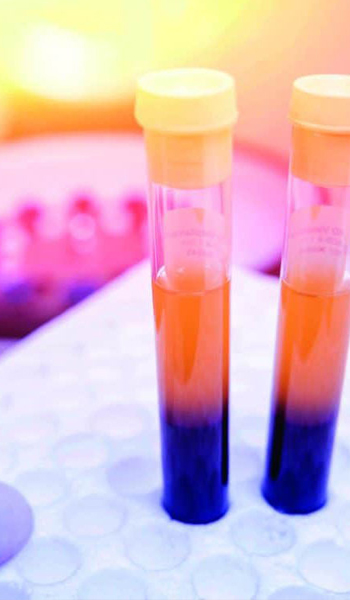PRP (platelet-enriched plasma) is an effective treatment for androgenetic alopecia. It is intended for men and women who want to stop their hair loss and restore their hair. PRP is a non-surgical treatment that stimulates hair growth, it is used to treat hair miniaturization. PRP injections have proven to be effective for many years in many surgical and medical specialities. PRP has been very successful in recent years for its application in hair loss and miniaturization treatment, as a full-fledged treatment or as part of a comprehensive hair restoration also including a hair transplant. Blood contains platelets that release growth factors. Growth factors trigger tissue regeneration mechanisms, which is why PRP is used in the field of hair restoration.

PRP
Learn more
PRP was introduced in dermatology after researchers discovered that high platelet concentrations in plasma help stimulate hair regrowth by prolonging the growth phase of the hair cycle. Therefore, in the field of hair restoration, platelet-enriched plasma is injected into the scalp (in bald areas) where hair loss or hair miniaturization has occurred.
Seek advice from an experienced hair transplant specialist and get a free quote.
The treatment
Doctors started using PRP a little over 10 years ago to speed up the healing process of damaged joints after an injury or surgery. During the treatment, a sample of the patient’s blood is taken. This blood is centrifuged to separate platelets from the plasma. The platelet-enriched part of the sample is then injected in the target area to repair blood vessels, boost collagen production, enhance cell renewal and wound healing. In the case injections in the scalp, PRP is used for hair growth stimulation. PRP was introduced in dermatology after researchers discovered that high platelet concentrations in plasma help stimulate hair regrowth by prolonging the growth phase of the hair cycle. Therefore, in the field of hair restoration, platelet-enriched plasma is injected into the scalp (in bald areas) where hair loss or hair miniaturization has occurred.

To find out how much hair grafts are needed to get the result you expect as well as the cost of your hair restoration, get in touch with Dr.Seffen, qualified hair transplant specialist.
Benefits of PRP
- Natural hair growth stimulation
- Increased hair volume and density
- Strengthening of existing hair
- Hair quality improvement
- Hair loss slowdown
- Only non-surgical and non-pharmaceutical treatment that has proven effective
- Can be combined with other therapies and medications
What can be treated with PRP ?
- Androgenetic alopecia: most common form of hair loss, mainly due to hormonal disturbances.
- Diffuse hair loss: caused by physiological changes such as stress and nutritional deficiencies.
- Alopecia areata: autoimmune disease causing hair loss in certain areas or the entire scalp.
Entrust your hair transplant to an experienced FUE specialist to benefit from a perfectly natural result with no scars.
What results can be expected ?
PRP contains a concentrated mixture of cytokines and growth factors that can be injected into the treatment area. This leads to stimulation of the dormant follicles and hair regrowth. It has been observed that PRP treatment improves the health, strength and individual diameter of hairs while preventing further hair loss. These properties are used to maintain the number of hair and induce varying degrees of hair regrowth depending on the patient. PRP is effective for both men and women, stopping hair loss, making thinning hair thicker and increasing hair density and strength.

Learn more
Although there is improvement in hair texture, thickness and growth in the treated area after about two weeks, it usually takes 3 to 6 months for the full result to appear.

